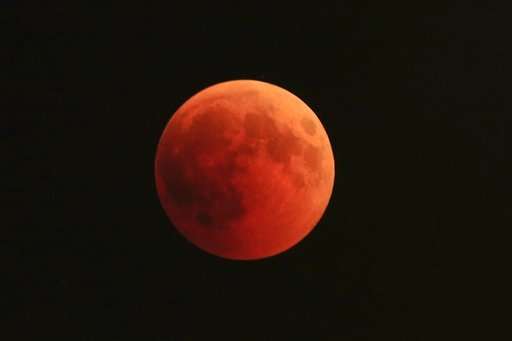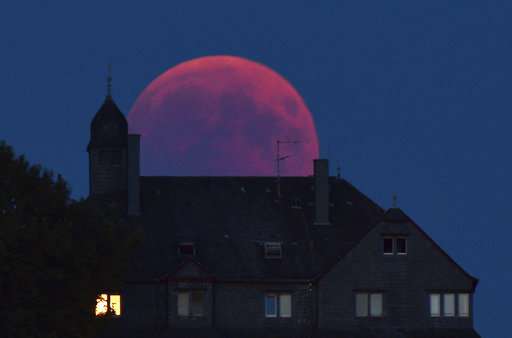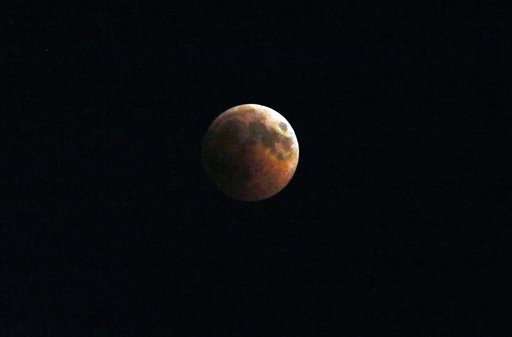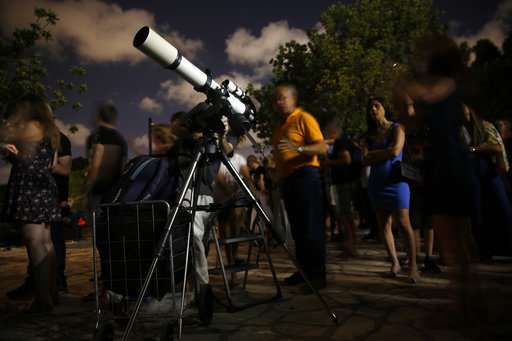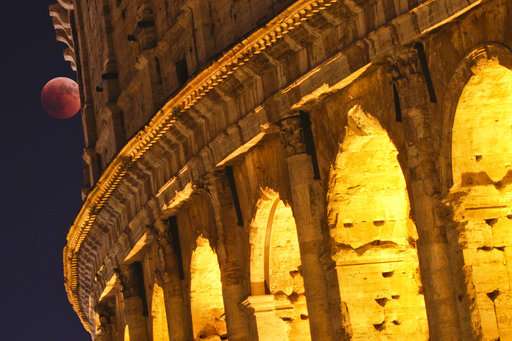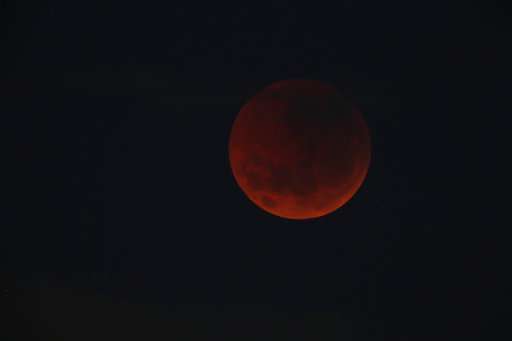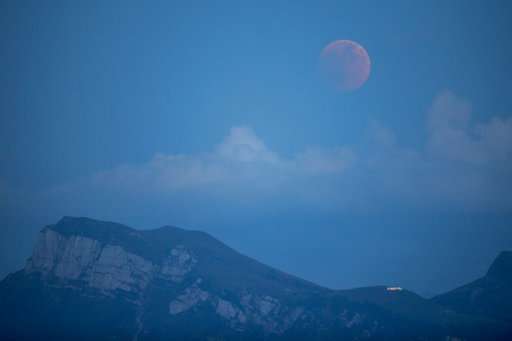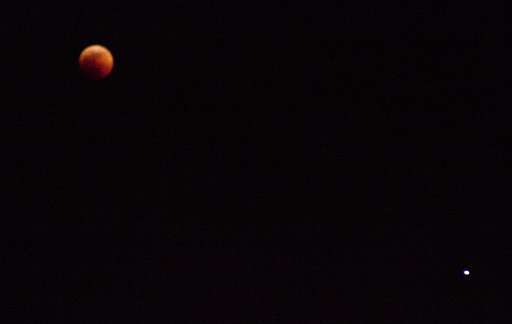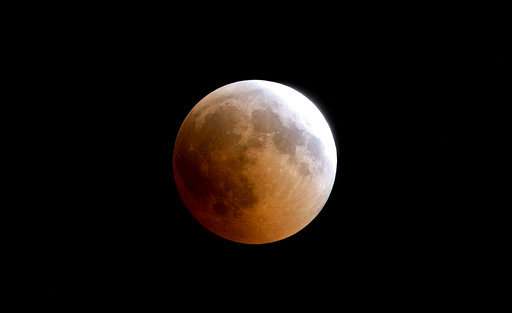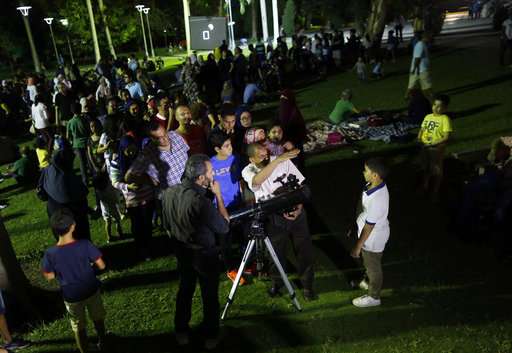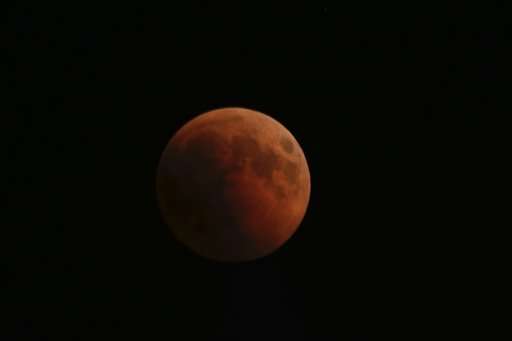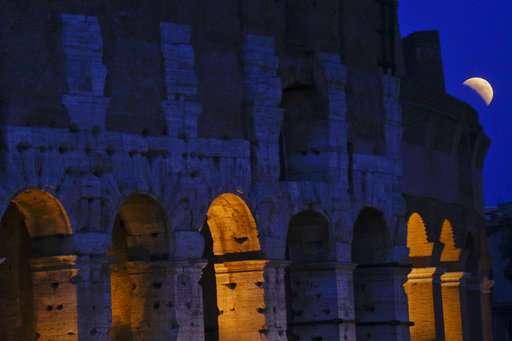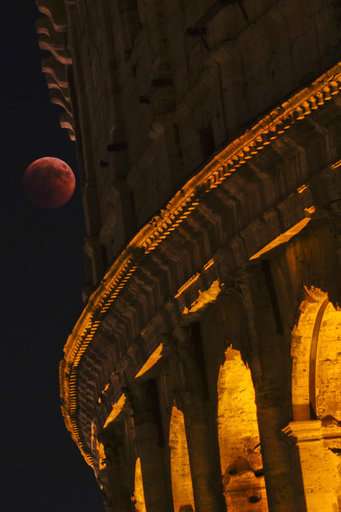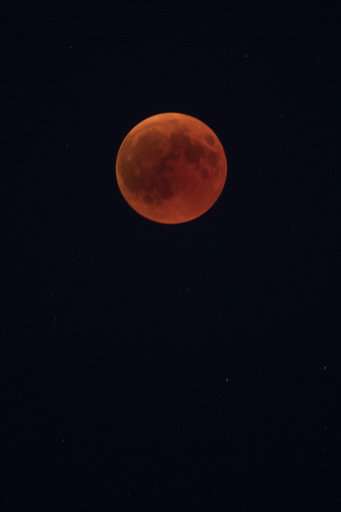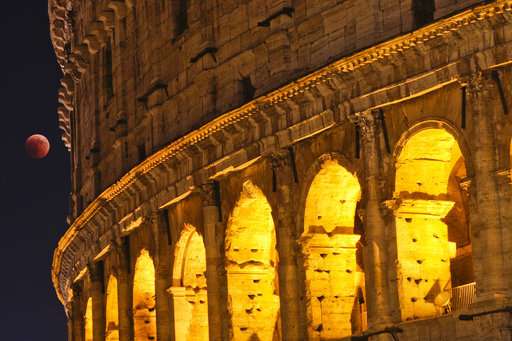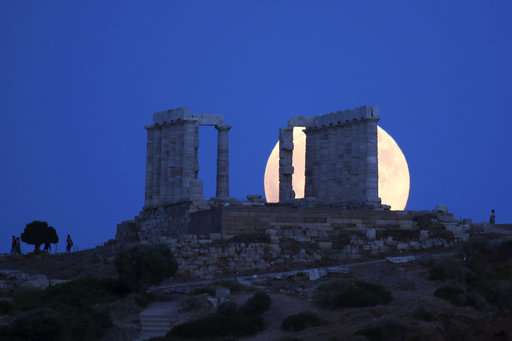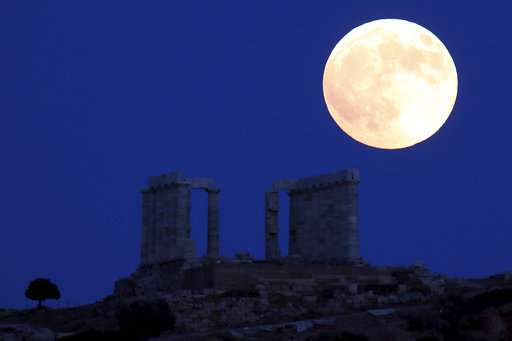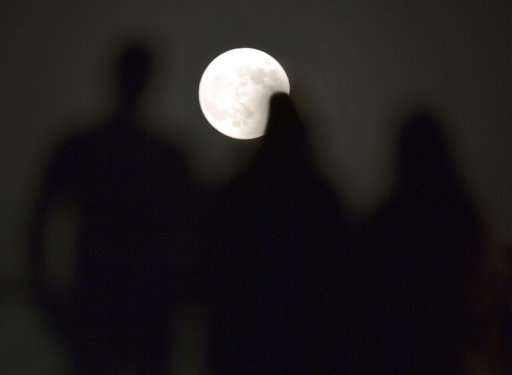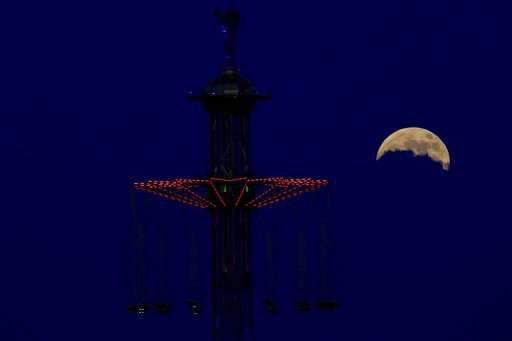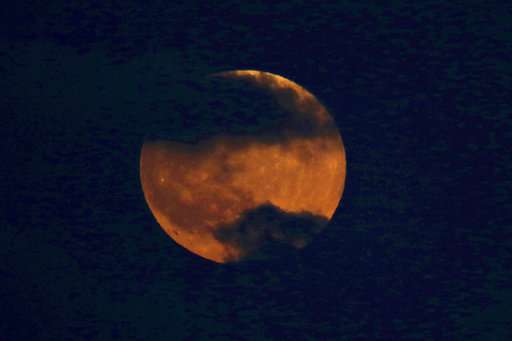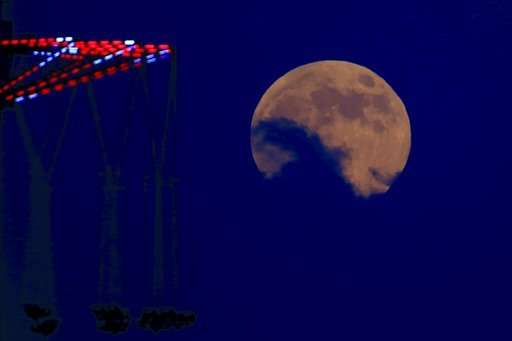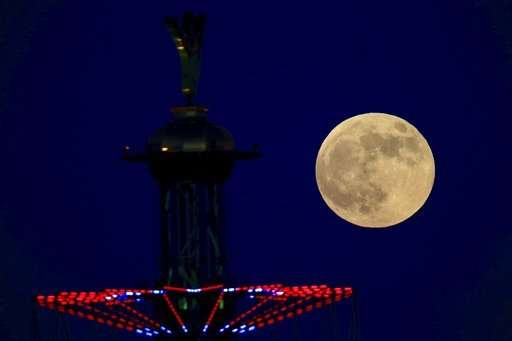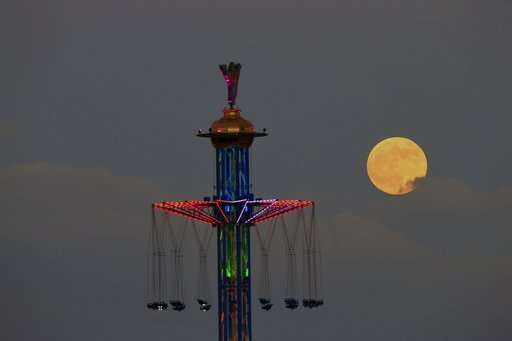The moon turns red during a total lunar eclipse in Giv'atayim, Israel, Friday, July 27, 2018. Skywatchers around much of the world are looking forward to a complete lunar eclipse that will be the longest this century. (AP Photo/Ariel Schalit)
Skywatchers around much of the world have begun watching a complete lunar eclipse that is the longest of this century.
The so-called "blood moon," when it turns a deep red, is visible at different times in Australia, Africa, Asia, Europe and South America when the sun, Earth and moon line up perfectly, casting Earth's shadow on the moon.
The total eclipse lasts 1 hour and 43 minutes, with the entire event lasting closer to four hours.
Across Africa people turned to the sky, watching the reddish shadow slide up the moon's surface. In Somalia, some hurried to mosques for special prayers often observed during lunar eclipses. In South Sudan, some dared to take photos in a war-torn country where using a camera in public is discouraged.
In Ethiopia's capital, Addis Ababa, people at an open-air restaurant admired a rare clear view during the rainy season, comparing a live NASA webcast to what they saw above. Then clouds rolled in.
"Dem yelebesech chereka," some murmured—Amharic for "blood moon."
"The reason that the moon turns red is because atmospheric scattering causes red light to pass through the atmosphere and the composition of the atmosphere can change if volcanic eruptions or forest fires occur," said Tom Kerss, an astronomer with the Royal Observatory Greenwich.
The moon turns red during a total lunar eclipse in Bernkastel-Kues, Germany, Friday, July 27, 2018. Skywatchers around much of the world are looking forward to a complete lunar eclipse that will be the longest this century. (Harald Tittel/dpa via AP)
"And the density of dust increasing in the atmosphere can cause the moon to appear a particularly deep red, and indeed it has the same effect on our sunsets and sunrises."
In a special treat, Mars is also at its closest approach to Earth this week since 2003, making it appear bigger and brighter.
Excited skywatchers on social media shared photos of the bright planet just to the right of the moon.
North America missed out on Friday's lunar eclipse but can look forward to the next one on Jan. 21, 2019, according to NASA.
-
A blood moon rises over Turkish capital Ankara, Turkey, late Friday, July 27, 2018. Skywatchers around much of the world are looking forward to a complete lunar eclipse that will be the longest this century. The so-called "blood moon" Friday, when it turns a deep red, will be visible at different times in Australia, Africa, Asia, Europe and South America when the sun, Earth and moon line up perfectly, casting Earth's shadow on the moon. (AP Photo/Burhan Ozbilici)
-
People watch the moon turn red during a lunar eclipse in Giv'atayim, Israel, Friday, July 27, 2018. Skywatchers around much of the world are looking forward to a complete lunar eclipse that will be the longest this century. (AP Photo/Ariel Schalit)
-
The moon is framed by the Colosseum during a complete lunar eclipse, in Rome, Friday, July 27, 2018. The so-called "blood moon" Friday, when it turns a deep red, will be visible at different times in Australia, Africa, Asia, Europe and South America when the sun, Earth and moon line up perfectly, casting Earth's shadow on the moon.(AP Photo/Gregorio Borgia)
-
The moon turns red over Sydney during a lunar eclipse Saturday, July 28, 2018. Skywatchers around much of the world are looking forward to a complete lunar eclipse that will be the longest this century. (AP Photo/Rick Rycroft)
-
The moon turns red during a total lunar eclipse, as seen from Lucerne, Switzerland, Friday, July 27, 2018. Skywatchers around much of the world are looking forward to a complete lunar eclipse that will be the longest this century. (Urs Flueeler/Keystone via AP)
-
A blood moon is seem with Mars on the bottom right (white dot), in Nairobi, Friday, July 27, 2018. Skywatchers around much of the world are looking forward to a complete lunar eclipse that will be the longest this century. The so-called "blood moon" Friday, when it turns a deep red, will be visible at different times in Australia, Africa, Asia, Europe and South America when the sun, Earth and moon line up perfectly, casting Earth's shadow on the moon. (AP Photo/Sayyid Abdul Azim)
-
A blood moon rises over Gaza City, Friday, July 27, 2018. Skywatchers around much of the world are looking forward to a complete lunar eclipse that will be the longest this century. The so-called "blood moon" Friday, when it turns a deep red, will be visible at different times in Australia, Africa, Asia, Europe and South America when the sun, Earth and moon line up perfectly, casting Earth's shadow on the moon. (AP Photo/Hatem Moussa)
-
People line up to watch the lunar eclipse through a telescope at the Children's Civilization and Creativity Center in Cairo, Egypt, Friday, July 27, 2018. Skywatchers around much of the world are looking forward to a complete lunar eclipse that will be the longest this century. (AP Photo/Amr Nabil)
-
The moon turns red during a total lunar eclipse in Giv'atayim, Israel, Friday, July 27, 2018. Skywatchers around much of the world are looking forward to a complete lunar eclipse that will be the longest this century. (AP Photo/Ariel Schalit)
-
The moon rises past the Colosseum during a complete lunar eclipse, in Rome, Friday, July 27, 2018. The so-called "blood moon" Friday, when it turns a deep red, will be visible at different times in Australia, Africa, Asia, Europe and South America when the sun, Earth and moon line up perfectly, casting Earth's shadow on the moon.(AP Photo/Gregorio Borgia)
-
The moon is framed by the Colosseum during a complete lunar eclipse, in Rome, Friday, July 27, 2018. The so-called "blood moon" Friday, when it turns a deep red, will be visible at different times in Australia, Africa, Asia, Europe and South America when the sun, Earth and moon line up perfectly, casting Earth's shadow on the moon.(AP Photo/Gregorio Borgia)
-
The moon turns red during a total lunar eclipse, as seen from Lucerne, Switzerland, Friday, July 27, 2018. Skywatchers around much of the world are looking forward to a complete lunar eclipse that will be the longest this century. (Urs Flueeler/Keystone via AP)
-
A full moon rises next to the Colosseum during a complete lunar eclipse, in Rome, Friday, July 27, 2018. The so-called "blood moon" Friday, when it turns a deep red, will be visible at different times in Australia, Africa, Asia, Europe and South America when the sun, Earth and moon line up perfectly, casting Earth's shadow on the moon. (AP Photo/Gregorio Borgia)
-
A full moon rises behind the ancient temple of Poseidon in cape Sounio, about 65 kilometers (40miles) south of Athens, Friday, July 27, 2018. The complete lunar eclipse Friday when the sun, Earth and moon line up perfectly to cast Earth's shadow on the moon, will be the longest this century. It's called a "blood moon" because it turns a deep red and will be visible at different times around the world. Additionally, Mars and the sun will be on exact opposite sides of the Earth and will shine its best. (AP Photo/Thanassis Stavrakis)
-
Full moon rises over the ancient temple of Poseidon in cape Sounio, about 65 kilometers (40miles) south of Athens, Friday, July 27, 2018. The complete lunar eclipse Friday when the sun, Earth and moon line up perfectly to cast Earth's shadow on the moon, will be the longest this century. It's called a "blood moon" because it turns a deep red and will be visible at different times around the world. Additionally, Mars and the sun will be on exact opposite sides of the Earth and will shine its best. (AP Photo/Thanassis Stavrakis)
-
People watch the lunar eclipse at the Children's Civilization and Creativity Center in Cairo, Egypt, Friday, July 27, 2018. Skywatchers around much of the world are looking forward to a complete lunar eclipse that will be the longest this century. (AP Photo/Amr Nabil)
-
A blood moon rises Tel Aviv, Israel, Friday, July 27, 2018. Skywatchers around much of the world are looking forward to a complete lunar eclipse that will be the longest this century. The so-called "blood moon" Friday, when it turns a deep red, will be visible at different times in Australia, Africa, Asia, Europe and South America when the sun, Earth and moon line up perfectly, casting Earth's shadow on the moon. (AP Photo/Ariel Schalit)
-
A blood moon rises over Tel Aviv, Israel, Friday, July 27, 2018. Skywatchers around much of the world are looking forward to a complete lunar eclipse that will be the longest this century. The so-called "blood moon" Friday, when it turns a deep red, will be visible at different times in Australia, Africa, Asia, Europe and South America when the sun, Earth and moon line up perfectly, casting Earth's shadow on the moon. (AP Photo/Ariel Schalit)
-
A blood moon rises over Tel Aviv, Israel, Friday, July 27, 2018. Skywatchers around much of the world are looking forward to a complete lunar eclipse that will be the longest this century. The so-called "blood moon" Friday, when it turns a deep red, will be visible at different times in Australia, Africa, Asia, Europe and South America when the sun, Earth and moon line up perfectly, casting Earth's shadow on the moon. (AP Photo/Ariel Schalit) (AP Photo/Ariel Schalit)
-
A blood moon rises over Tel Aviv, Israel, Friday, July 27, 2018. Skywatchers around much of the world are looking forward to a complete lunar eclipse that will be the longest this century. The so-called "blood moon" Friday, when it turns a deep red, will be visible at different times in Australia, Africa, Asia, Europe and South America when the sun, Earth and moon line up perfectly, casting Earth's shadow on the moon. (AP Photo/Ariel Schalit)
-
A blood moon rises over Tel Aviv, Israel, Friday, July 27, 2018. Skywatchers around much of the world are looking forward to a complete lunar eclipse that will be the longest this century. The so-called "blood moon" Friday, when it turns a deep red, will be visible at different times in Australia, Africa, Asia, Europe and South America when the sun, Earth and moon line up perfectly, casting Earth's shadow on the moon. (AP Photo/Ariel Schalit)
© 2018 The Associated Press. All rights reserved.
